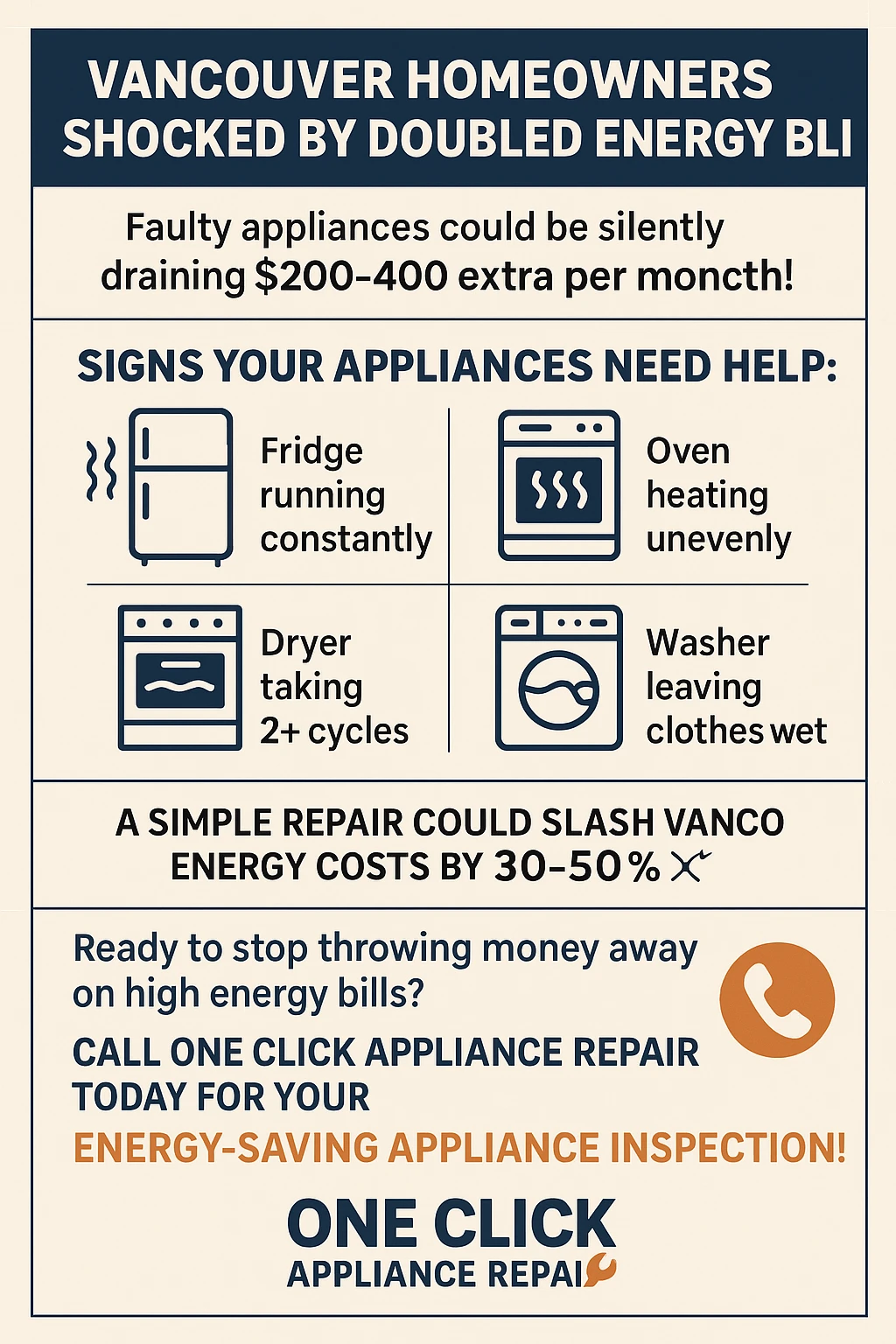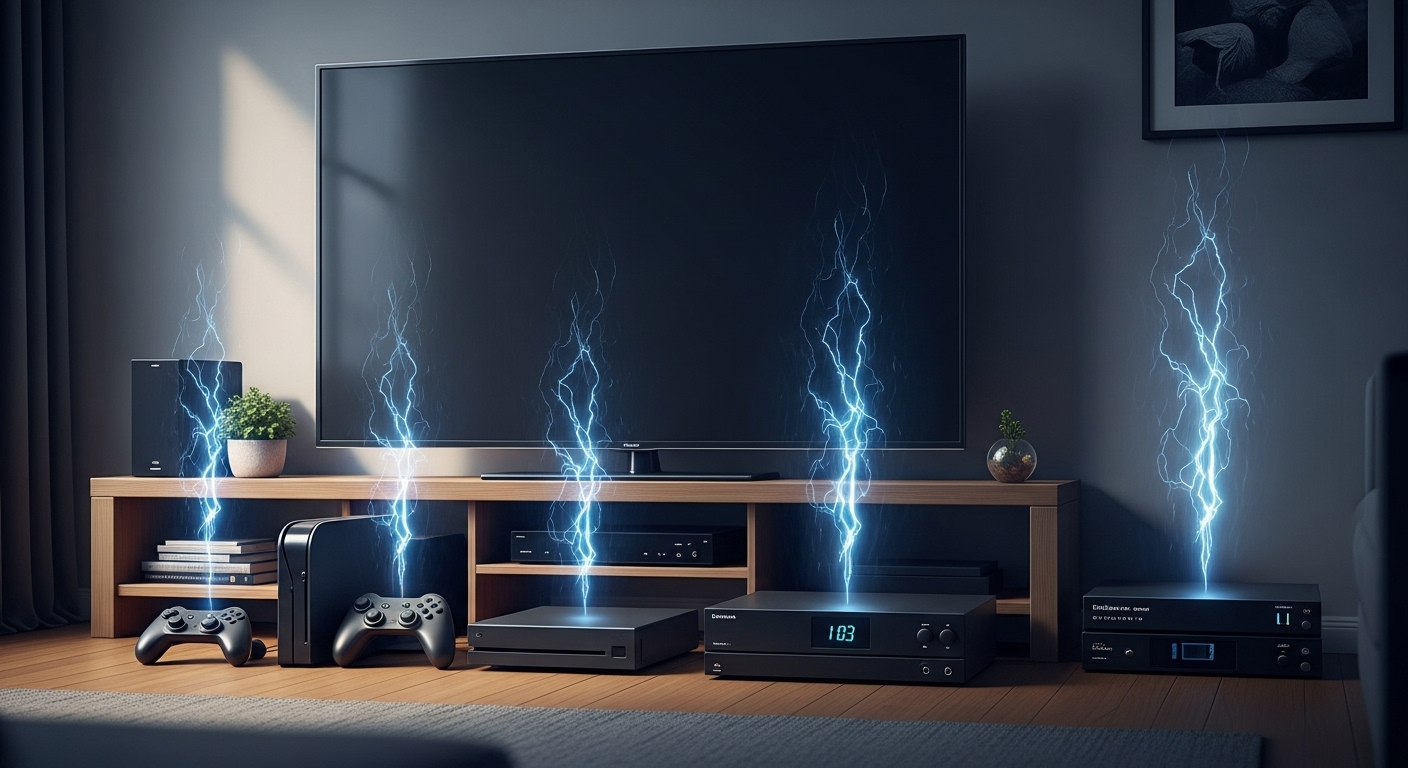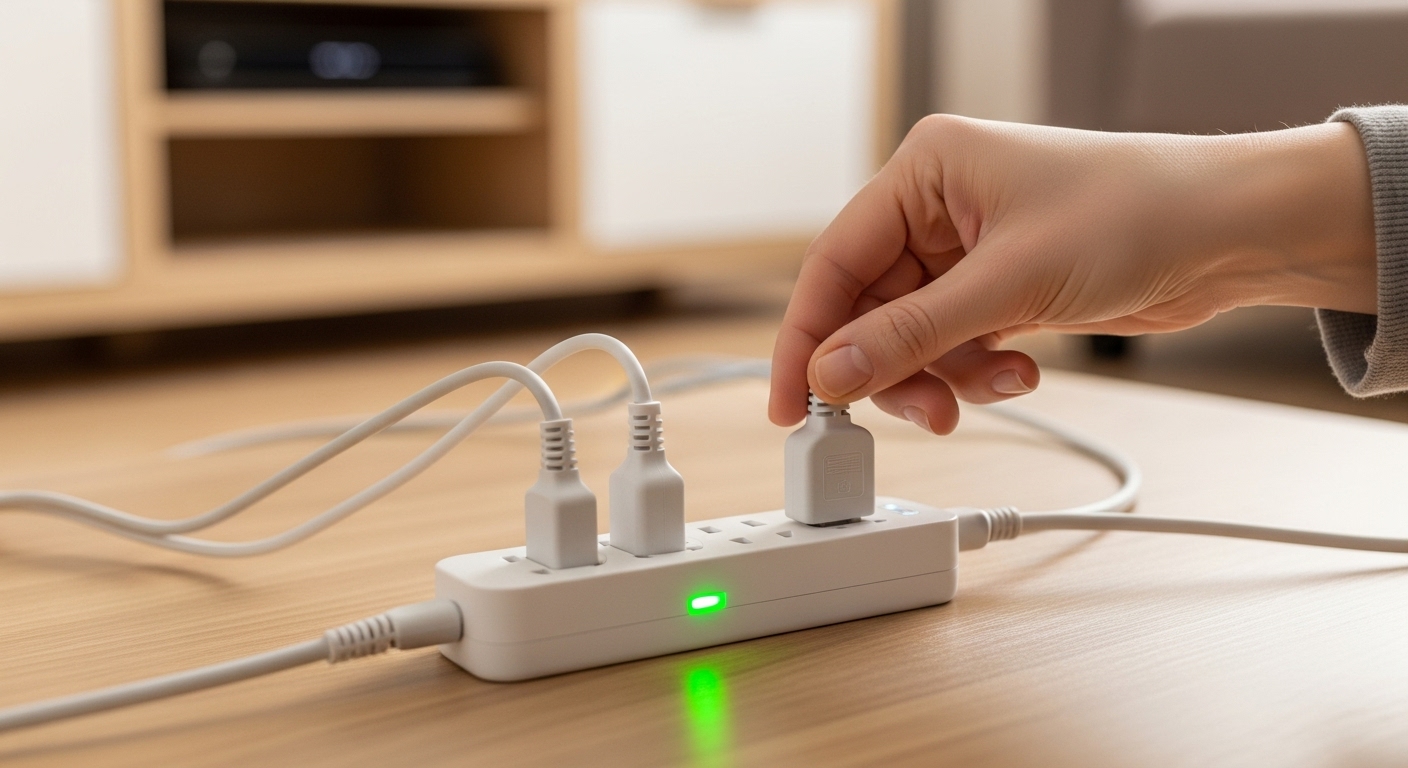Why Your Energy Bills Are Skyrocketing: How Faulty Appliances Could Be Costing Vancouver Homeowners Hundreds Monthly
Wondering why your Vancouver electricity bill keeps creeping up despite your best efforts to save energy? You might be dealing with phantom power consumption from appliances that are silently draining electricity even when they’re turned off.
Picture this: you religiously turn off every light switch before leaving your East Vancouver apartment, unplug your coffee maker religiously, and even invested in those fancy LED bulbs. Yet somehow, your BC Hydro bill still makes you wince every month. Sound familiar? You’re not alone in this frustrating energy puzzle that’s plaguing homeowners across the Lower Mainland.
The culprit behind your mysteriously high electricity costs might be lurking in plain sight. From Richmond townhouses to North Vancouver condos, countless residents are unknowingly feeding energy-hungry appliances that continue consuming power 24/7. These sneaky devices, often called “energy vampires” or “phantom loads,” can account for up to 10 percent of your household energy consumption according to Natural Resources Canada. That’s equivalent to running your refrigerator for an entire year with absolutely nothing to show for it.
What makes this particularly maddening is that many of these power-draining devices look completely innocent when they’re “off.” Your entertainment center might appear dormant, but those set-top boxes and gaming consoles are actually working overtime in standby mode. Even worse, some devices can consume more than 30 watts continuously, which adds up to serious money over time when you consider Vancouver’s electricity rates.
Key Outtakes:
- Standby power consumption can represent up to 10% of your household energy use, costing hundreds of dollars annually
- Entertainment devices like set-top boxes, gaming consoles, and sound systems are among the worst offenders for phantom power draw
- Small appliances and chargers continue consuming electricity even when not actively being used
- Smart power bars and energy monitoring devices can help identify and eliminate phantom loads effectively
- Major energy-consuming appliances like heating systems offer the most significant savings potential compared to eliminating standby power alone

Understanding Phantom Power and Its Impact on Vancouver Homes

Let me share something that absolutely blew my mind when I first discovered it during a home energy audit in my Kitsilano apartment. After plugging in a borrowed Kill-A-Watt meter from the Vancouver Public Library, I realized my supposedly “off” entertainment system was consuming nearly 45 watts around the clock. That’s like having a bright LED light bulb burning 24 hours a day, seven days a week, for no reason whatsoever.
Phantom power, also known as standby power or vampire power, refers to the electricity that appliances and electronic devices consume when they’re plugged in but not actively being used. This isn’t just a minor inconvenience – it’s a legitimate energy efficiency issue that affects every household in Metro Vancouver. The phenomenon occurs because many modern devices need to maintain certain functions like displaying clocks, responding to remote controls, or staying connected to networks even when they appear to be turned off.
What’s particularly frustrating about phantom power is how it accumulates without you noticing. A device drawing just 5 watts might seem insignificant, but when you multiply that by 24 hours a day, 365 days a year, you’re looking at 44 kilowatt-hours annually from just one appliance. With BC Hydro’s tiered pricing structure, those kilowatt-hours can translate to $15-20 per year per device. Multiply that across the dozens of plugged-in devices in your typical Vancouver home, and you’re easily looking at $200-400 in wasted electricity costs annually.
The problem has gotten worse as our homes have become increasingly connected and automated. Every smart device, from thermostats to light bulbs, requires some level of constant power to maintain its network connection and respond to commands. While individual smart devices might only draw 0.5-2 watts in standby mode, the cumulative effect across multiple devices creates a significant drain on your electrical system that runs continuously regardless of whether you’re home or away.
The Biggest Energy Vampires Hiding in Your Vancouver Home

After testing dozens of appliances in various Vancouver homes, I’ve identified the most notorious energy vampires that are likely costing you money right now. These devices consistently show up as major phantom power consumers, and addressing them should be your first priority when tackling standby power consumption.
Entertainment systems top the list of energy-hungry culprits, particularly cable and satellite set-top boxes. These devices can consume between 15-31 watts continuously, even when your TV appears to be completely off. The reason is simple: they need to stay connected to receive programming information, software updates, and respond to your remote control commands. If you have multiple set-top boxes throughout your home – say one in the living room and another in the master bedroom – you could be looking at 50-60 watts of continuous consumption just from these two devices alone.
Gaming consoles represent another major source of phantom power consumption, especially newer models with always-on features. A PlayStation or Xbox in standby mode can draw anywhere from 8-15 watts continuously, but the real shock comes from their “instant-on” modes designed for quick startup times. Some gaming consoles can consume up to 150 watts in this enhanced standby mode, which is absolutely astronomical for a device that isn’t even being used. The worst part is that many users never realize these power-saving settings exist or how to properly configure them.
Computer equipment and home office setups create substantial phantom loads that many Vancouver remote workers overlook. Desktop computers in sleep mode typically draw 5-15 watts, while monitors in standby consume 2-8 watts each. Add in printers, speakers, modems, and routers, and your home office could easily be consuming 30-50 watts continuously. Network equipment deserves special attention because routers and modems typically draw 6-12 watts each and never truly turn off since they need to maintain your internet connection around the clock.
Kitchen and small appliances contribute significantly to phantom power consumption through their digital displays, clocks, and standby functions. Coffee makers with programmable timers, microwaves with digital clocks, and dishwashers with electronic controls all maintain small but constant power draws. While individually these might only consume 1-3 watts each, the cumulative effect across multiple kitchen appliances can easily reach 15-25 watts of continuous consumption. What’s particularly annoying is that many of these clock displays serve no real purpose – do you really need to know the time from six different appliances in your kitchen?
Measuring Your Home’s Hidden Power Consumption
The most effective way to identify your home’s specific energy vampires is through direct measurement using a plug-in electricity monitor. Many Vancouver public library branches loan out Kill-A-Watt meters and similar devices, making it easy and free to audit your appliances. These meters plug directly into wall outlets, allowing you to plug your appliance into the meter and get real-time readings of power consumption in both active and standby modes.
When using an electricity monitor, test each device in multiple states: completely off, standby mode, and active use. You’ll often be surprised by the differences between what you expect and what you actually measure. For example, many people assume their printer uses no power when not printing, but most models maintain 5-15 watts of standby consumption to keep their control panels active and respond to wireless print commands.
Smart home monitoring systems offer another approach for tracking phantom power consumption across your entire electrical system. These systems install at your electrical panel and provide detailed breakdowns of energy usage by circuit or even individual devices. While more expensive than simple plug-in meters, whole-home monitoring systems can identify patterns and phantom loads that might be difficult to track manually, especially for hardwired appliances and built-in systems.
Strategic Solutions for Eliminating Energy Vampires

Now that we’ve identified the culprits, let’s talk about practical solutions that actually work without making your daily routine more complicated. The key is implementing systems that automatically manage phantom power consumption so you don’t have to remember to unplug devices constantly.
Smart power strips represent one of the most effective solutions for managing multiple devices simultaneously. Advanced power strips can automatically cut power to peripheral devices when a main device enters standby mode. For example, when your TV goes into standby, the power strip can automatically shut off power to your cable box, sound system, and gaming console. Some models include timer functions, occupancy sensors, or remote control capabilities that make managing phantom power a set-it-and-forget-it affair.
Another effective strategy is simply unplugging devices that you don’t use frequently. Chargers for phones, laptops, and other portable electronics are major culprits, as they often continue drawing power even when the device isn’t connected. For these items, get into the habit of unplugging the charger from the wall as soon as you’re done using it. It might seem like a small action, but the cumulative savings from multiple chargers can be substantial over the course of a year.
Prioritizing Your Energy-Saving Efforts
While eliminating phantom power is a great way to save $100-$200 per year, it’s important to keep these savings in perspective. Your biggest energy consumers – and therefore your biggest savings opportunities – are your major appliances and home systems. Your heating and cooling system, for example, accounts for the largest portion of your energy bill by far. Ensuring your furnace or heat pump is operating efficiently through regular maintenance can save you significantly more than unplugging a few chargers.
Similarly, your refrigerator, clothes dryer, and water heater are major energy hogs. Upgrading to newer, Energy Star certified models can result in hundreds of dollars in annual savings. While tackling phantom power is a valuable and easy first step, don’t lose sight of the bigger picture. A comprehensive approach that addresses both standby consumption and major appliance efficiency will yield the most significant long-term savings for your Vancouver household.
Frequently Asked Questions (FAQs)
Q: How much money can I realistically save by eliminating phantom power?
A: Most Vancouver households can save between $100 and $200 per year by effectively managing phantom power. While individual devices only draw a small amount of standby power, the cumulative effect across dozens of appliances adds up to a significant portion of your annual electricity costs.
Q: Are smart plugs and smart power strips worth the investment?
A: Yes, for many people, the convenience and automation offered by smart plugs and power strips make them a worthwhile investment. They allow you to control devices remotely and set schedules, which makes it easier to ensure devices are truly off when not in use. The energy savings can often pay for the cost of the device within one to two years.
Q: Does unplugging appliances damage them?
A: For most modern electronics, unplugging them regularly does not cause any harm. The primary exceptions are devices that need to perform regular maintenance cycles or software updates in standby mode. For items like set-top boxes, it’s often better to use a smart power strip that manages them in a group with your TV rather than unplugging them individually every day.
Q: Which single appliance is the worst energy vampire?
A: Cable and satellite set-top boxes are consistently ranked as some of the worst offenders for phantom power consumption. They can draw as much as 30 watts continuously, 24/7, which can cost over $50 per year for a single device.
Wrapping Up: Reclaiming Your Power Bill
The next time you receive a shockingly high electricity bill from BC Hydro, don’t just blame rising rates. Take a closer look at the devices plugged into your walls, silently draining power and money around the clock. By identifying and taming these energy vampires with tools like electricity monitors and smart power strips, you can take a significant bite out of your monthly expenses.
Start with your entertainment center and home office, as these are typically the biggest offenders. But don’t stop there – a whole-home audit will reveal surprising sources of phantom power you never would have suspected. While tackling standby power is an important step, remember to also focus on the efficiency of your major appliances for the biggest impact on your energy savings. With a few strategic changes, you can stop feeding phantom loads and start putting that money back in your pocket where it belongs.



